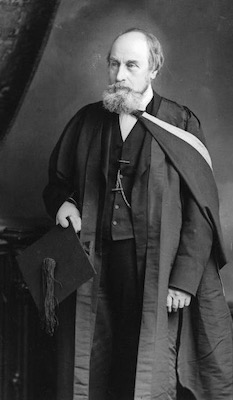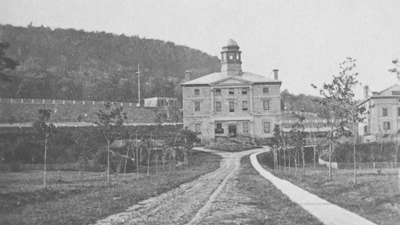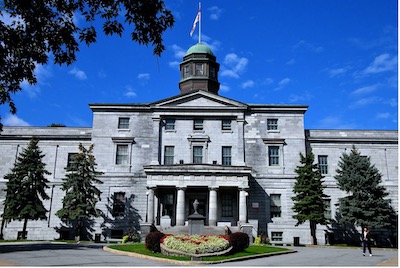The Faculty of Arts welcomed its first students when the first edifice purpose-built for McGill College officially opened on September 6, 1843. This opening ceremony was the long-awaited product of a Royal Charter that Lord Dalhousie, the Governor General of Canada, had granted in 1821 on behalf of King George IV, providing for the establishment of the college and declaring that it should be given the power to confer degrees. The ceremony had been delayed by the lack of university infrastructure, but by spring 1843, two buildings had been completed and were ready to house the Faculty of Arts. These were the Arts Building and the East Wing, which is now Dawson Hall.
In those early days, the student population was small, and the curriculum focused primarily on classical studies, but lectures on mathematics, logic, French, history, geography, and law were also offered. To obtain a degree in the Faculty of Arts, students followed a three-year program in one of two streams: one focused on classics and the other on mathematics, logic, and ethics. The student fees were originally fixed at £5 per year with an additional 10 shillings required as a matriculation fee. To join the ordinary classes, students sat a matriculation examination, which mainly covered Latin and Greek grammar.

In 1855, Sir John William Dawson became Principal and ushered in an era of transformation. Nova Scotia-born Dawson was offered the position despite the fact that he had little formal education to speak of, having studied at the Pictou Academy in Nova Scotia and then briefly attended the University of Edinburgh. His appointment spoke to a desire to move McGill away from European university models towards something new and decidedly Canadian.
When Dawson first arrived in Montreal, the campus was in a dilapidated state. Little construction had taken place since the opening of the Arts Building and the East Wing, and the land surrounding these structures was unkempt and overgrown. In 1852, construction by the City of Montreal on the McTavish reservoir had caused large boulders to roll down the hill and damage the Arts Building. The faculty and students were forced to carry out classes in Burnside Hall, a High School of Montreal building on University Street, today home to the Fine Arts Core Education School.
Dawson began an ambitious revitalization project. He encouraged efforts to refresh the campus landscape and appealed for donations from the citizens of Montreal to continue building up the university. The City of Montreal agreed to pay compensation for the damage to the Arts Building, and by 1860, the Faculty of Arts moved back from Burnside Hall. Within the next year, the businessman and philanthropist William Molson arranged the construction of a West Wing building, intended to contain a convocation hall, library, and museum. By 1865, the building had been completed, along with corridors connecting the wings to the central building.

Dawson’s plan for renewal also included changes to the curriculum. In his 1855 inaugural address to the board of governors, Dawson spoke about the importance of studying ancient languages—Hebrew, Ancient Greek, and Latin—alongside modern ones, especially English. He also emphasized the study of logic, philosophy, and law, which he sought to strengthen at McGill through the hiring of new faculty. Finally, Dawson stressed the value of the sciences—something he felt particularly invested in having spent much of his life studying geology—underscoring their value in society. His intention was clear: he sought to create a program of study at McGill that would equip students for the practical needs of life in the mid-nineteenth century by exposing them to a variety of subjects. Dawson also established the McGill Normal School to train teachers who would be able to prepare students for a university education. This program of curricular expansion was quickly taken on board, and by 1856 the Faculty of Arts was offering a wider range of subjects than had previously been deemed possible.

The year Dawson began his career at McGill, 110 students registered at the beginning of the fall session. Of these students, 38 were in the Faculty of Arts, which consisted of five professors and one lecturer. Slowly but surely, the University began to expand at a more sustained rate than it had before. By 1860, 60 students were registered in the Faculty of Arts. The Faculty continued to grow, benefiting not only from the excitement of the broader curriculum but also from the encouragement of donations such as Henry Chapman’s 1857 pledge to provide a gold medal for the outstanding student in the Faculty of Arts’ graduating class. This trend was taken up by others who endowed medals for particular achievements, such as the Shakespeare Gold Medal, which was endowed by a group of Montreal citizens who wished to recognize the bolstering of the study of English language and literature at McGill. Yet, in spite of these developments, enrolment in the Faculty of Arts was limited to men until 1884.
